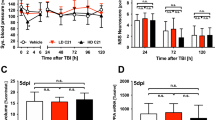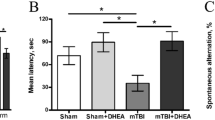Abstract
Traumatic brain injury triggers the accumulation of harmful mediators that may lead to secondary damage1,2. Protective mechanisms to attenuate damage are also set in motion2. 2-Arachidonoyl glycerol (2-AG) is an endogenous cannabinoid, identified both in the periphery3 and in the brain4, but its physiological roles have been only partially clarified5,6,7. Here we show that, after injury to the mouse brain, 2-AG may have a neuroprotective role in which the cannabinoid system is involved. After closed head injury (CHI) in mice, the level of endogenous 2-AG was significantly elevated. We administered synthetic 2-AG to mice after CHI and found significant reduction of brain oedema, better clinical recovery, reduced infarct volume and reduced hippocampal cell death compared with controls. When 2-AG was administered together with additional inactive 2-acyl-glycerols that are normally present in the brain, functional recovery was significantly enhanced. The beneficial effect of 2-AG was dose-dependently attenuated by SR-141761A, an antagonist of the CB1 cannabinoid receptor.
This is a preview of subscription content, access via your institution
Access options
Subscribe to this journal
Receive 51 print issues and online access
We are sorry, but there is no personal subscription option available for your country.
Buy this article
- Purchase on SpringerLink
- Instant access to full article PDF
Prices may be subject to local taxes which are calculated during checkout






Similar content being viewed by others
References
Povlishock, J. T. & Christman, C. W. The pathobiology of traumatically induced axonal injury in animals and humans: A review of current thoughts. J. Neurotrauma 12, 555–564 (1995).
Kochanek, P. M. et al. Biochemical, cellular, and molecular mechanisms in the evolution of secondary damage after severe traumatic brain injury in infants and children: Lessons learned from the bedside. Pediatr. Crit. Care Med. 1, 4–19 (2000).
Mechoulam, R. et al. Identification of an endogenous 2-monoglyceride, present in canine gut, that binds to cannabinoid receptors. Biochem. Pharmacol. 50, 83–90 (1995).
Sugiura, T. et al. 2-Arachidonoylglycerol: A possible endogenous cannabinoid receptor ligand in brain. Biochem. Biophys. Res. Commun. 215, 89–97 (1995).
Mechoulam, R., Fride, E. & Di Marzo, V. Endocannabinoids. Eur. J. Pharmacol. 359, 1–18 (1998).
Piomelli, D., Giuffrida, A., Calignano, A. & Rodriguez de Fonseca, F. The endocannabinoid system as a _target for therapeutic drugs. Trends Pharmacol. Sci. 21, 218–223 (2000).
Axelrod, J. & Felder, C. C. Cannabinoid receptors and their endogenous agonist, anandamide. Neurochem. Res. 23, 575–581 (1998).
McIntosh, T. K., Juhler, M. & Wieloch, T. Novel pharmacologic strategies in the treatment of experimental traumatic brain injury J. Neurotrauma 15, 731–769 (1998).
Gallily, R., Breuer, A. & Mechoulam, R. 2-Arachidonylglycerol, an endogenous cannabinoid, inhibits tumor necrosis factor α production in murine macrophages, and in mice. Eur. J. Pharmacol. 406, R5–R7 (2000).
Chan, P. H. Reactive oxygen radicals in signaling and damage in the ischemic brain. J. Cereb. Blood Flow Metab. 21, 2–14 (2001).
Shohami, E., Ginis, I. & Hallenbeck, J. M. Dual role of tumor necrosis factor α in brain injury. Cytokines Growth Factor Rev. 10, 119–130 (1999).
Chen, Y., Constantini, S., Trembovler, V., Weinstock, M. & Shohami, E. An experimental model of closed head injury in mice: Pathophysiology, histopathology and cognitive deficits. J. Neurotrauma 13, 557–568 (1996).
Beni-Adani, L. et al. A peptide derived from activity-dependent neuroprotective protein (ADNP) ameliorates injury response in closed head injury in mice. J. Pharmacol. Exp. Ther. 296, 57–63 (2001).
Mathews, K. S. et al. Rapid quantification of ischaemic injury and cerebroprotection in brain slices using densitometric assessment of 2,3,5-triphenyltetrazolium chloride staining. J. Neurosci. Meth. 102, 43–51 (2000).
Ben-Shabat, S. et al. An entourage effect: Inactive endogenous fatty acid glycerol esters enhance 2-arachidonoyl glycerol cannabinoid activity. Eur. J. Pharmacol. 353, 23–31 (1998).
Adams, I. E., Compton, D. R. & Martin, B. R. Assessment of anandamide interaction with the cannabinoid brain receptor: SR141716A antagonism studies in mice and autoradiographic analysis of receptor binding in rat brain. J. Pharmacol. Exp. Ther. 284, 1209–1217 (1998).
Smith, S. R., Terminelli, C. & Denhardt, G. Effects of cannabinoid receptor agonist and antagonist ligands on production of inflammatory cytokines and anti-inflammatory interleukin-10 in endotoxemic mice. J. Pharmacol. Exp. Ther. 293, 136–150 (2000).
Shohami, E., Shapira, Y., Yadid, G., Reisfeld, N. & Yedgar, S. Brain phospholipase A2 is activated after experimental closed head injury in rats. J. Neurochem. 53, 1541–1546 (1989).
Nadler, V., Biegon, A., Beit-Yannai, E., Adamchik, J. & Shohami, E. 45Ca accumulation in rat brain after closed head injury; attenuation by the novel neuroprotective agent HU-211. Brain Res. 685, 1–11 (1995).
Reggio, P. H. & Traore, H. Conformational requirements for endocannabinoid interaction with the cannabinoid receptors, the anandamide transporter and fatty acid amidohydrolase. Chem. Phys. Lipids 108, 15–35 (2000).
Goparaju, S. K., Ueda, N., Yamaguchi, H. & Yamamoto, S. Anandamide amidohydrolase reacting with 2-arachidonoylglycerol, another cannabinoid receptor ligand. FEBS Lett. 422, 69–73 (1998).
Sinor, A. D., Irvin, S. M. & Greenberg, D. A. Endocannabinoids protect cerebral cortical neurons from in vitro ischemia in rats. Neurosci. Lett. 278, 157–160 (2000).
Shen, M. & Thayer, S. A. Cannabinoid receptor agonists protect cultured rat hippocampal neurons from excitotoxicity. Mol. Pharmacol. 54, 459–462 (1998).
Nagayama, T. et al. Cannabinoids and neuroprotection in global and focal cerebral ischemia and in neuronal cultures. J. Neurosci. 19, 2987–2995 (1999).
van der Stelt, M. et al. Neuroprotectin by Delta9-tetrahydrocannabinol, the main active compound in marijuana, against ouabain-induced in vivo excitotoxicity. J. Neurosci. 21, 6475–6479 (2001).
Hansen, H. S., Moesgaard, B., Hansen, H. H. & Petersen, G. N-acylethanolamines and percursor phospholipids—relation to cell injury. Chem. Phys. Lipids 108, 135–150 (2000).
Shohami, E. & Mechoulam, R. Dexanabinol (HU-211): A nonpsychotropic cannabinoid with neuroprotective properties. Drug Develop. Res. 50, 211–215 (2000).
Sugiura, T., Yoshinaga, N., Kondo, S., Waku, K. & Ishima, Y. Generation of 2-arachidonoylglycerol, an endogenous cannabinoid receptor ligand, in picrotoxinin-administered rat brain. Biochem. Biophys. Res. Comm. 271, 654–658 (2000).
Klein, T. W., Lane, B., Newton, C. A. & Friedman, H. The cannabinoid system and cytokine network. Proc. Soc. Exp. Biol. Med. 225, 1–8 (2000).
Ovadia, H., Wohlman, A., Mechoulam, R. & Weidenfeld, J. Characterization of the hypothermic effect of the synthetic cannabinoid HU-210 in the rat. Relation to the adrenergic system and endogenous pyrogens. Neuropharmacology 34, 175–180 (1995).
Chen, Y. et al. Human brain capillary endothelium. 2-Arachidonoylglycerol (endocannabinoid) interacts with endothelin-1. Circ. Res. 87, 323–327 (2000).
Acknowledgements
We thank the US National Institute of Drug Abuse and the Israel Science Foundation for support (grants to R.M.). E.S. and R.M. are affiliated with the David R. Bloom Center for Pharmacy at the Hebrew University of Jerusalem's School of Pharmacy.
Author information
Authors and Affiliations
Corresponding author
Rights and permissions
About this article
Cite this article
Panikashvili, D., Simeonidou, C., Ben-Shabat, S. et al. An endogenous cannabinoid (2-AG) is neuroprotective after brain injury. Nature 413, 527–531 (2001). https://doi.org/10.1038/35097089
Received:
Accepted:
Issue Date:
DOI: https://doi.org/10.1038/35097089



